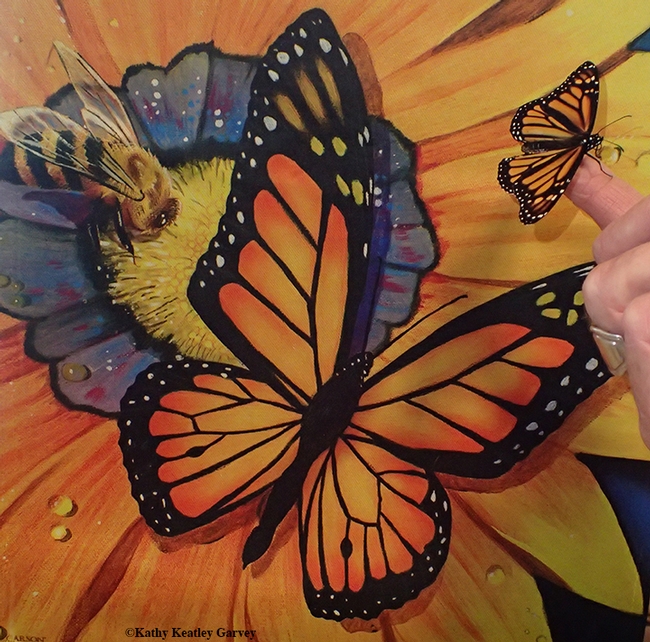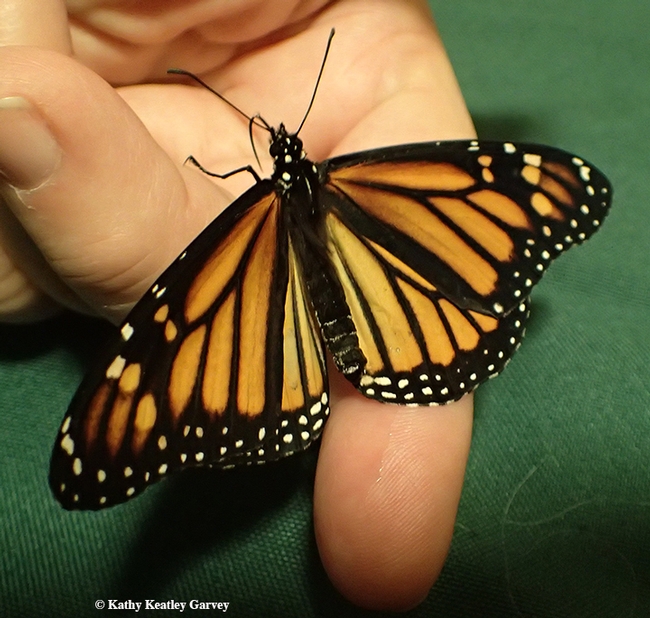- Author: Kathy Keatley Garvey
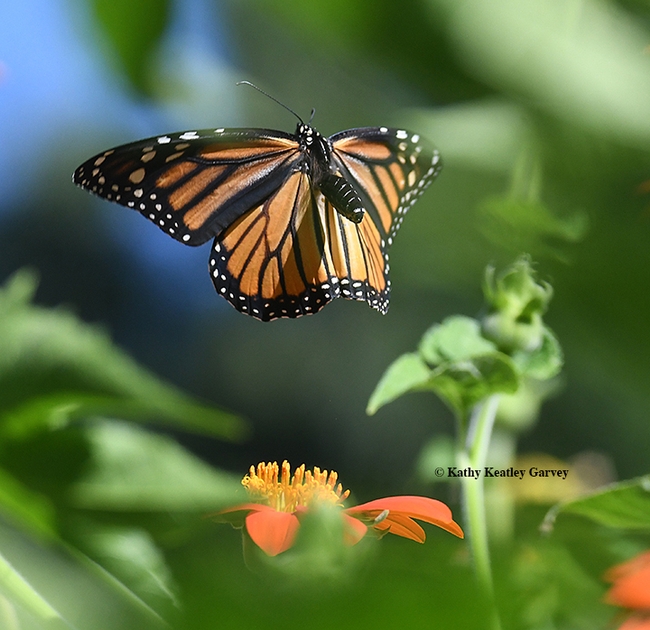
"Guess, who's back?" has nothing to do with the catchphrases uttered by Arnold Schwarzenegger and Jack Nicholson. (Remember when Schwarzenegger promised "I'll be back!" in the 1984 science fiction film, The Terminator, and Nicholson vowed "I'm back" in the 1980 psychological horror film, The Shining?)
Who's back?
Monarch butterflies, Danaus plexippus. Well, at least one monarch is back in the area.
Shapiro sighted a female monarch today in West Sacramento, Yolo County. "It was in good shape, not looking stressed. Of course, Asclepias (native milkweed) has not broken ground."
It's an early sighting, which probably means the coastal clusters may be breaking up early due to the warmer weather than usual.
Shapiro, who maintains a research website at http://butterfly.ucdavis.edu/, has monitored butterfly population trends on a transect across central California since 1972. The 10 sites stretch from the Sacramento River Delta through the Sacramento Valley and Sierra Nevada mountains to the high desert of the Western Great Basin.
The previous plexippus he's seen before Feb. 10 include:
- Jan. 29, 2020 (See Bug Squad blog)
- Feb.1, 2014
- Feb. 9, 2006
- Feb. 9, 1976
"And lots in February after the 10th."
Meanwhile, most of the 250,000 monarchs tallied in California during the Thankgsiving Count, directed by the Xerces Society of Invertebrate Conservation, are still overwintering. Note that this is a 100-fold increase from the 2020 Thanksgiving Count when Xerces recorded a mere 2000.
Western monarchs generally begin clustering at their overwintering sites along coastal California in the late fall, peaking in size in late November or early December. Mating season usually begins around Valentine's Day. The monarchs traditionally depart their overwintering sites in late February or the beginning of March and head inward.
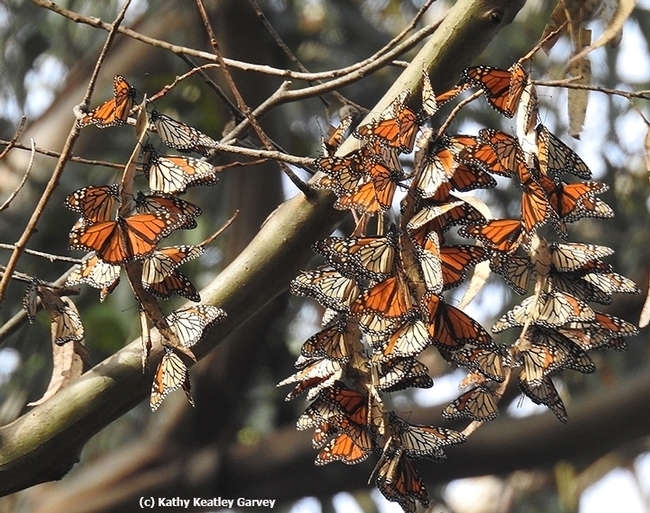
- Author: Kathy Keatley Garvey
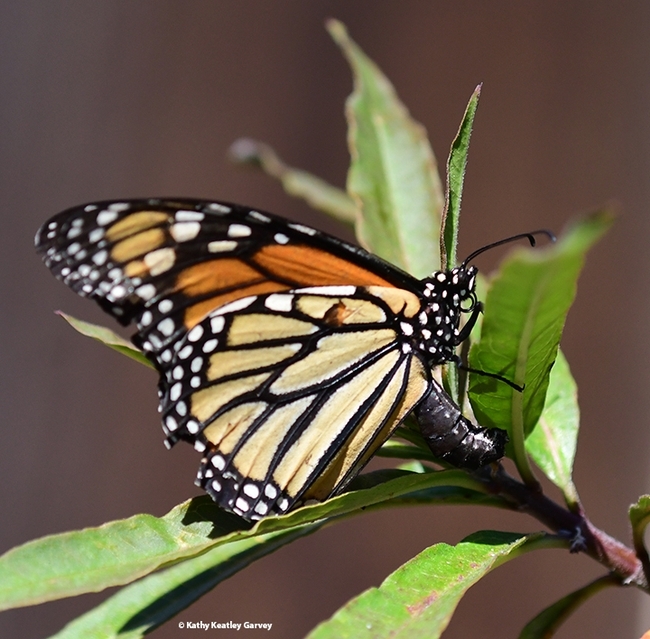
And how long misinformation can linger...
Take the news about the overwintering 250,000 monarchs recorded along the California coast in the Western Monarch Thanksgiving Count spearheaded by the Xerces Society for Invertebrate Conservation. That's more than a 100-fold increase from the previous year.
Butterfly guru Art Shapiro, a UC Davis distinguished professor of evolution and ecology who has been monitoring butterfly populations in Central California since 1972--and maintains a research website at https://butterfly.ucdavis.edu--wants to know where they came from. He acknowledges he does not know, nor does anyone else. Yet.
Lynn Kimsey, director of the Bohart Museum of Entomology and a UC Davis distinguished professor of entomology, says we shouldn't consider the population increase a trend, that it's still too early to figure out what's going on.
Says Bohart associate Greg Kareofelas: "I think it is hopeful, but we will not know for sure until 5 or 10 years have gone by. One year is not a trend."

- "It is great to have more breathing room, but we're not out of the woods yet, in terms of conservation. The current population is still < 5% of our estimates from the 1980's and has only been that large for one year."
- "When populations reach unprecedented sets of conditions (in this case, lower overwintering numbers than we had ever seen before, from 2018-2020), we should expect the unexpected. And one thing to emphasize is"
- "We expect large fluctuations in abundance of butterflies and many other insect species. We need to manage for resilience, because we probably won't be able to understand every crash or rebound." (See her UC Davis seminar)

But a key point is this: "There are NOT two populations of the monarch in North America," says migration expert and monarch scientist Hugh Dingle, emeritus professor, UC Davis Department of Entomology and Nematology. "The population is all one and the butterflies from all over North America mix in Mexico during the winter diapause. The monarchs breeding in the west (of the Rockies) have at least two (and probably three) migration routes in the fall--one is to the California coast, one is down the Colorado River Valley into Mexico, and the probable third is east of the Great Salt Lake and west of the Wasatch down through eastern Arizona and into Mexico. Sample sizes are small for the third route which is why it is only probable. Also genetic data going back 50 years shows that the North American population is all one, that is, work by Walter Eanes and others including recent molecular genetics studies!"
The western migration routes are outlined in Dingle et al. Biological Journal of the Linnaean Society 85:491-500 (2005), and for various evolutionary changes in monarch migration and correlated characters see Freedman, Dingle, et al. B. J. Linn. Soc. 123:265-278 (2018), Animal Migration 5:61-73 (2018), and the Proceedings of the National Academy of Sciences (PNAS) 117: 28887-28893(2020) and references therein.
Commented Dingle: "The old saw about two North American populations is a good example of once something gets into the literature--or into the public domain-- it becomes exceedingly difficult to correct."
Now scientists are trying to figure out what contributed to the increase in the population. And where they came from.
Remember back in 2019 when Shapiro declared that the monarch population is on life support?
Hold on...
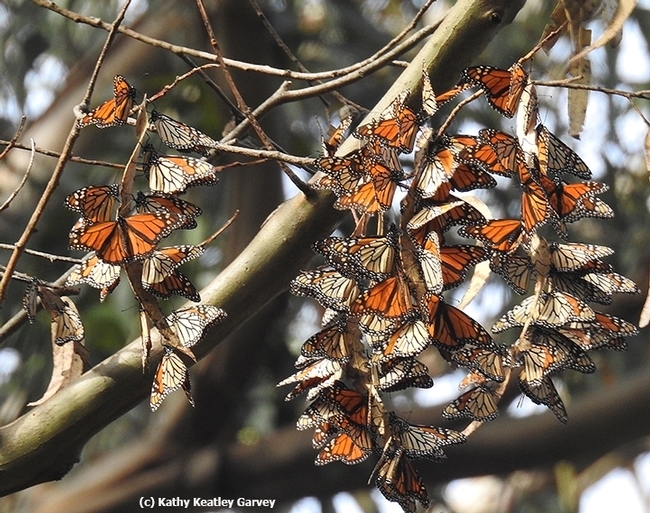
- Author: Kathy Keatley Garvey
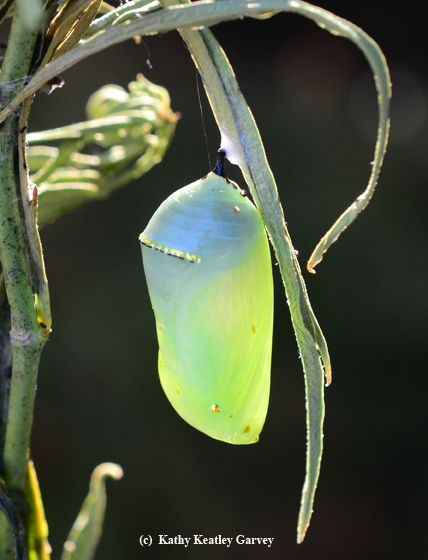
It was a dismal year in Vacaville (and other parts of California) for monarch-rearing. Of the 10 caterpillars we collected from milkweed in our pollinator garden in early September and tried to rear, only eight made it.
One caterpillar died when a sibling attacked it. Another caterpillar made it to the chrysalis stage, and then it succumbed.
"The intersegmental membranes are showing," observed butterfly guru Art Shapiro, UC Davis distinguished professor of evolution and ecology, who has researched butterflies for more than four decades and maintains a research website at http://butterfly.ucdavis.edu. "Whatever caused that, it opens the door to severe water loss, so the pupa will probably die."
Yes, it did.
Black lines rimmed the non-viable chrysalis, and then it deteriorated almost beyond recognition.
Lynn Epstein, UC Davis emeritus professor of plant pathology, photographed it under a Leica DVM6 microscope on Nov. 2. An amazing image.
Meanwhile, perhaps the eight monarchs we reared and released made it to an overwintering site along the California coast...maybe to the eucalyptus grove at the Natural Bridges State Park, Santa Cruz.
Or maybe they encountered a predator--a praying mantis or a bird.
Regardless, the declining monarch populations at the overwintering sites along coastal California are troubling.
The Xerces Society for Invertebrate Conservation, based in Portland, Ore., noted in a news release Feb. 2, 2018 that the "annual census of monarch butterflies overwintering along California's coast reveals that populations in western North America are at their lowest point in five years, despite recovery efforts. Volunteers with the Xerces Society's Western Monarch Thanksgiving Count visited more sites this past year than have ever been counted since the survey began in 1997, yet they tallied fewer than 200,000 monarchs."
“This year's numbers indicate a continuing decline in the monarch population,” noted Sarina Jepsen, the Xerces Society's endangered species program director. “Two decades ago, more than 1.2 million monarchs were recorded from far fewer coastal sites, and just last year nearly 300,000 monarchs were observed at almost the same number of sites.” Population estimates at individual sites also suggest that the western monarch population has continued to shrink. Of the 15 sites which have been monitored annually for more than two decades, 11 had lower counts than last year."
Also in the news release, Emma Pelton, conservation biologist with Xerces, said: “Counts at some of the state's largest sites were dramatically lower. Pismo Beach State Park was down by 38 percent, a private site in Big Sur was down by 50 percent, and the Monarch Butterfly Sanctuary in Pacific Grove was down 57 percent, from 17,100 to just 7,350 butterflies.”
Xerces Society officials also noted that "the few sites in which monarch numbers remained stable or increased compared to 2016, include Natural Bridges State Park, Moran Lake, and Lighthouse Field State Park, all in Santa Cruz County."
We like to think that The Vacaville Eight were The Lucky Eight.
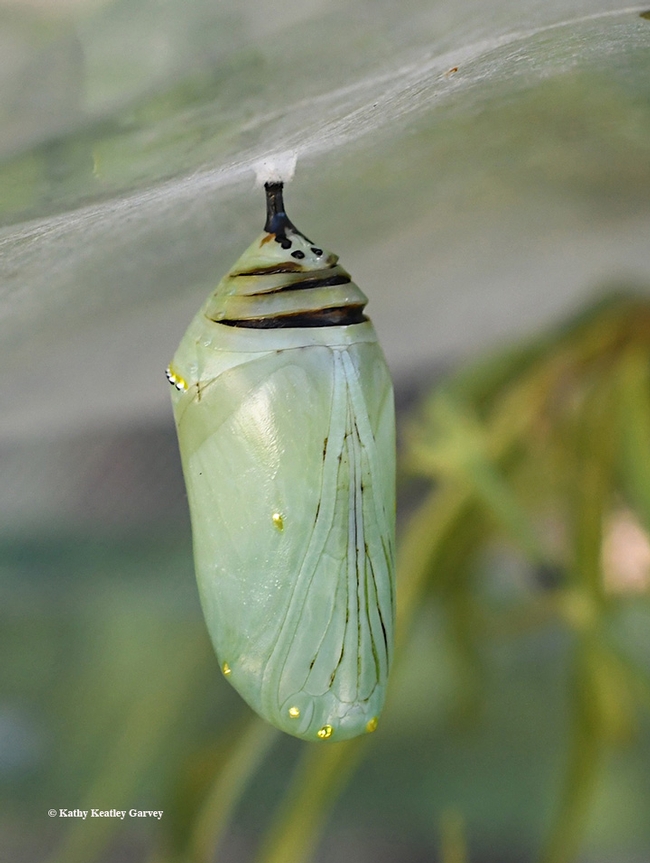
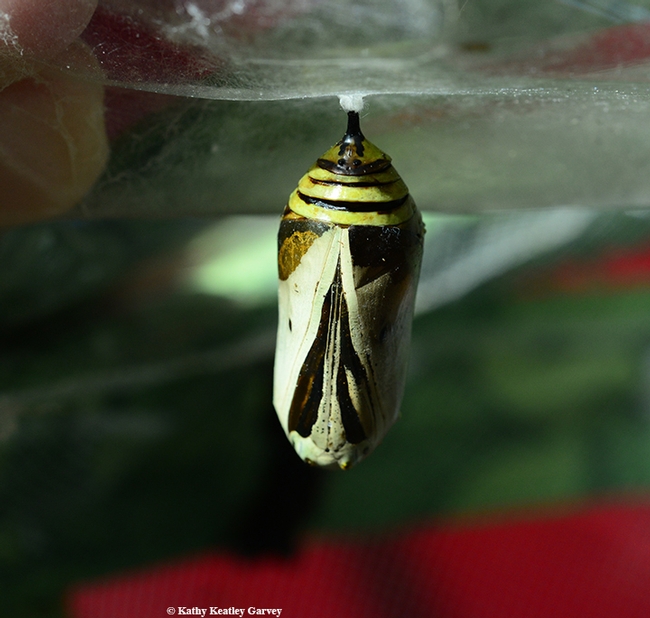
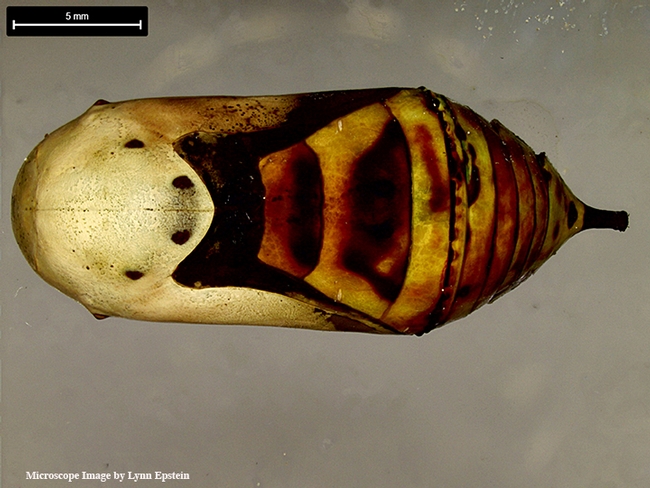
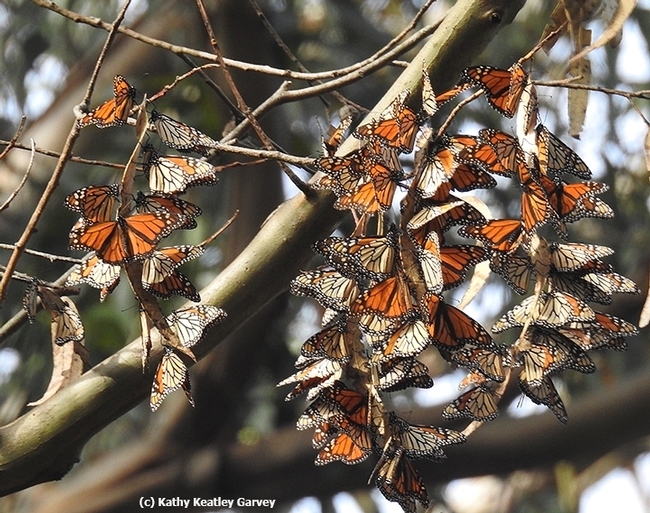
- Author: Kathy Keatley Garvey

The research paper covered the first five years, 2012 to 2016, of the ongoing project. Citizen scientists tagged and released nearly 15,000 monarchs in Washington, Oregon, Idaho and British Columbia in the late summer and fall. The number recovered? Sixty.
"On average, these butterflies averaged almost 40 miles of travel each day," James told the WSU News Service. "That's pretty remarkable for such a small creature."
One of the monarchs released Aug. 28, 2016 in Ashland, Ore., by citizen scientist Steven Johnson fluttered into our yard in Vacaville, Calif., on Sept. 5, a 457-kilometer journey. We happened to be home and photographed the traveler, a male. The discal cell tag read "monarch@wsu.edu 6093." WSU is my alma mater, so double excitement!
What was the longest recorded journey? A monarch that David James released in Yakima, Wash. It was recovered near Goleta, Calif., a distance of 845 miles.
When No. 6093 stopped in our yard for some flight fuel, he sipped nectar from Mexican sunflowers (Tithonia) and butterfly bush (Buddleia davidii) and milkweed (in this case, tropical milkweed, Asclepias curassavica.)
Scientists believe that monarchs ride warm air currents (thermals) a few thousand feet from the ground. Then, they use strong upper-air currents to navigate.
It's a long, tough journey, averaging nearly 500 miles, and often with strong winds, heavy rain, or triple-digit temperatures. They need food (nectar from flowers) and often they don't escape predators, including birds, praying mantids and spiders, and such diseases as Ophryocystis elektroscirrha, a protozoan parasite.
Perhaps some day migrating monarchs will be microchipped, if a lightweight chip is invented. "Then we can just chip 100 or 200 butterflies and not tag 15,000," James pointed out.
The research paper is titled "Citizen Scientist Tagging Reveals Destinations of Migrating Monarch Butterflies, Danaus plexippus (L.) from the Pacific Northwest." (See this site for the full text).
The abstract:
The fall migration of Monarch butterflies (Danaus plexippus) in the Pacific Northwest (PNW) was studied in an unfunded citizen science project during 2012—16 by tagging 13778 reared and 875 wild Monarchs. More than a third of these Monarchs were reared by inmates of the Washington State Penitentiary (WSP) in Walla Walla, Washington. Sixty (0.41 %) tagged Monarchs were recovered from distances greater than 10 km (mean: 792.9 ± 48.0 km) with most found in California, SSW of release points. One WSP-reared Monarch was found 724 km to the SE in Utah. Monarchs tagged in Oregon flew SSE to California. No Idaho-tagged Monarchs were found in California but two were recovered at locations due south. No wild tagged Monarchs from Washington, Oregon or Idaho were recovered. Monarchs from Washington and Oregon were found during October-February at 24 coastal California overwintering sites spanning 515 km from Bolinas to Carpinteria. A single wild spring Monarch tagged in May in northern California was recovered 35 days later and 707 km ENE in Twin Falls, Idaho. This study provides compelling evidence that many Monarchs in southern and central parts of Washington and Oregon migrate south in the fall to overwintering sites along the California coast. It also provides some evidence for southerly and south-easterly vectoring of migrating Monarchs from eastern Washington and Idaho, indicating the possibility of migration to Arizona or Mexico overwintering sites. In addition to improving our understanding of Monarch migration in the PNW, this study also contributed to conservation by adding nearly 14000 butterflies to the population. The incredible involvement of incarcerated and non-incarcerated citizen scientists generated much community and media interest which in turn led to greater involvement by citizens. Increased awareness of Monarchs, their biology and conservation in the PNW has been an unexpected but important spin-off of this study."
James is grateful for all the citizen scientists assisting with the project. It would not have been possible without them. Indeed, inmates at Walla Walla State Penitentiary alone reared one-third of the monarchs. (See feature story in Entomology Today, published by the Entomological Society of America.)
Here's what you can do to help the migrating monarchs on their journey:
- Plant nectar-rich flowers. They need flight fuel to continue their journey to the overwintering sites along coastal California.
- Don't use pesticides in your garden
- Keep your eye out for tagged migrating monarchs in the late summer and fall and try to photograph them.
- Visit overwintering sites, such as Natural Bridges State Park in Santa Cruz and the Monarch Butterfly Sanctuary in Pacific Grove, and look for--and record--tagged monarchs.
- Stay up-to-date by following the Facebook page, Monarch Butterflies in the Pacific Northwest. It now has nearly 5000 followers.
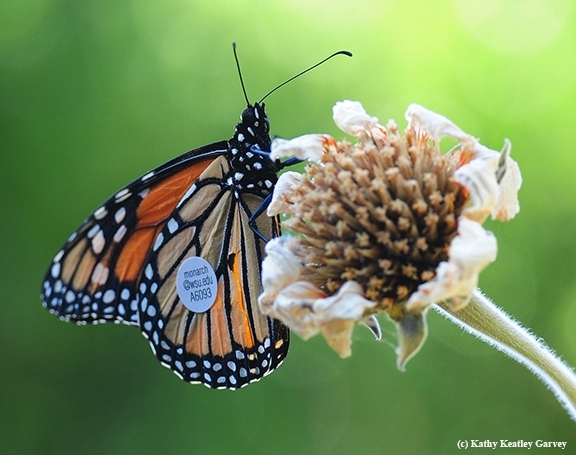

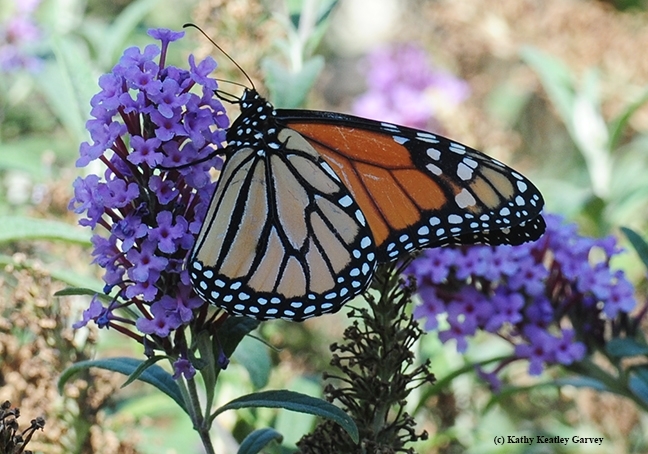
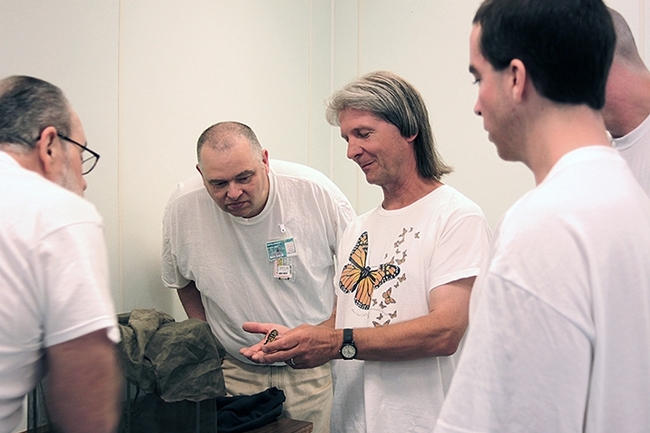

- Author: Kathy Keatley Garvey
It is not a good time to be a butterfly.
Especially if you're a monarch butterfly that eclosed on Jan. 5 in cold and rainy Vacaville, Calif. while all--or most--of your counterparts are overwintering along coastal California or in central Mexico. You don't even count; scientists and citizen scientists have already counted the overwintering monarch population and you're not there.
They do not know you exist.
You're nestled inside an indoor meshed butterfly habitat on a kitchen counter. Outside, a storm brews, not unlike the nearby coffee pot gurgling away. Inside, fingers of warmth comfort you. You sip a mixture of honey and water, and then orange juice. You sample the raspberries and blueberries. At night you perch on a rosemary branch. You wake up to the sounds of National Public Radio and the coffee pot gurgling. People come and go and look at you. "What are you doing here?" You ignore them.
You are alone. Your parents met and mated sometime in November. Your 11 siblings and cousins all eclosed on the last of the tropical milkweed, leaving you with basically nothing. You are the last one. A mid-life chrysalis if there ever was one. And now a maverick in the making. It's too cold and rainy to fly.
And then one of those humans comes by with a silkscreened garden flag and lifts you gently out of your zippered habitat. You eagerly investigate your new territory. You see a male monarch and a honey bee looking back at you. Life imitating art, or art imitating life?
